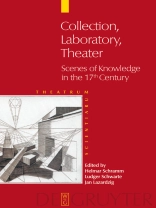This volume launches a new, eight-volume series entitled Theatrum Scientiarum on the history of science and the media which has arisen from the work of the Berlin special research project on ‘Performative Cultures’ under the aegis of the Theatre Studies Department of the Free University.
The volume examines the role of space in the constitution of knowledge in the early modern age. ‘Kunstkammern’ (art and curiosities cabinets), laboratories and stages arose in the 17th century as instruments of research and representation. There is, however, still a lack of precise descriptions of the epistemic contribution made by material and immaterial space in the performance of knowledge. Therefore, the authors present a novel view of the conditions surrounding the creation of these spatial forms. Account is taken both of the institutional framework of these spaces and their placement within the history of ideas, the architectural models and the modular differentiations, and the scientific consequences of particular design decisions. Manifold paths are followed between the location of the observer in the representational space of science and the organization in time and space of sight, speech and action in the canon of European theatrical forms. Not only is an account given of the mutual architectural and intellectual influence of the spaces of knowledge and the performance spaces of art; they are also analyzed to ascertain what was possible in them and through them.
This volume is the English translation of Kunstkammer, Laboratorium, Bühne (de Gruyter, Berlin, 2003).
Про автора
Helmar Schramm is Professor at the Theatre Studies Institute of the Free University of Berlin, Germany.Ludger Schwarte and Jan Lazardzig are research fellows in the interdisciplinary Berlin special research project on ‘Performative Cultures’ at the Free University of Berlin, Germany.












